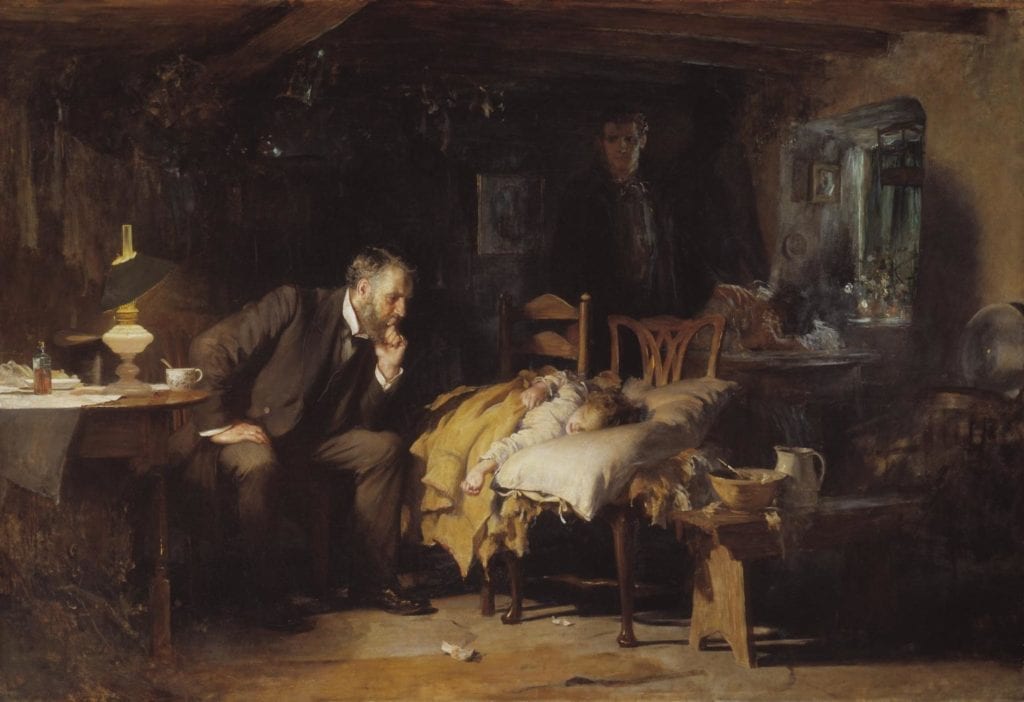Ami Schattner
Jerusalem, Israel
 |
| The Doctor. Sir Luke Fildes. Exhibited 1891. Photo © Tate. CC-BY-NC-ND 3.0 (Unported). |
One day each week I leave my hospital to serve as a consultant in ambulatory internal medicine. General practitioners from the area refer difficult patients to me, and thus my encounters vary from the very simple to the most challenging diagnostic riddles. Rachel belonged to the latter.
This elderly lively lady had seen many other consultants who had performed endless tests and even a lung biopsy, all failing to decipher the cause of her recent-onset interstitial lung disease and associated herpes zoster, fatigue, and weight loss. I soon focused on her spleen. It was enlarged and growing for no obvious reason. After ruling out entities such as viral infection, sarcoidosis, autoimmunity, and leukemia, I arranged for a splenic biopsy, which established a unifying diagnosis of primary splenic lymphoma. I saw her through a successful treatment that left her with no evidence of disease.
Rachel continued to see me for other minor problems such as weight gain and effort intolerance following corticosteroid treatment, or some pain that made her worried. Then I noticed something new.
She had briefly mentioned her grandson Jeremy once before, when she was about to take him on a trip to London for his coming Bar-Mitzvah. This was in the context of asking for prescriptions to cover her time abroad, but it must have been an unusual tenderness in her voice that caught my notice. On Rachel’s next visit weeks later, I asked about the trip, and she shared a touching story. Jeremy had recently been diagnosed as being on the autism spectrum. Until then, no one had been able to account for his sometimes erratic behavior. Nevertheless, he had always been her “special” grandchild and their London trip had been a splendid success. At the next visit she spoke of him again, and in fact Jeremy took up more time than all Rachel’s medical problems put together. She spoke of him in great detail and emotion, ending by showing me a photo. Looking so very fondly at the picture she said that she could not resist him and would do anything he asked of her. Jeremy was her first grandson, and though he could be quite difficult at times, calling her fifty times in a row with the same question, he would always be special to her. Not even his parents had that kind of patience with him. I listened, outwardly patient, never interrupting, but also covertly looking at my watch and weighing the long list of patients ahead, thinking, “When will all this end?”
While driving home in the evening, many hours later, I found myself contemplating the whole story of Rachel and Jeremy again. I realized that instead of irritation or impatience, I should have felt proud. By sharing her most precious feelings with me, I was being rewarded by my patient with an unmistakable vote of confidence and trust. Before I had been so engrossed in the cognitive enigma of Rachel’s obscure diagnosis that I had been completely blind to her as a person. Now I understood that her strong love for Jeremy and his dependence on her had been a powerful motivating force in her long ordeal and final recovery. She simply had to overcome her illness. No one else, not even Jeremy’s parents, really understood this child, or could respond to his special needs as she did. The transition from clinical enigma to a woman sharing her love of her grandson added the missing context to our encounters. I wish it had happened earlier.
Patient-physician communication is often brief, focused, and impersonal. The prevalent “biological” paradigm of our medical education and practice, coupled to time constraints, an overwhelming quantity of data, and the complexity of diagnostic and therapeutic decisions, make the recounting of any personal story, let alone the sharing of emotions, a challenge.1
Physician-initiated patient-centered care is advocated, but frequently remains neglected or rudimentary.2 Patients may offer cues to their feelings and concerns, but these are mostly not taken up by their physicians.3 However, the patient’s personal story, also called the “silent dimension” or “narrative,” is always an integral part of the clinical encounter.4 An attitude of sincere curiosity and a few moments of genuine interest from the physician may help to elicit this story.5 Once shared, the patient’s special circumstances create a bond between patient and practitioner, increasing the physician’s interest and commitment and the patient’s satisfaction and trust.
Reacting to Rachel’s hint and allowing her to tell her story bridged the gap between the diagnostic enigma she had first posed and her special grandson Jeremy. Listening to the story cemented our relationship and complemented her medical care. I was reminded that clinical encounters can always gain from hearing personal stories, and the key to finding them is mostly in the hands of the clinician.
References
- Dugdale DC, Epstein R, Pantilat SZ. Time and the patient-physician relationship. J Gen Intern Med 1999; 14 Suppl 1:S34-40.
- Epstein RM, Fiscella K, Lesser CS, Strange KC. Why the nation needs a policy push on patient-centered health care. Health Aff (Millwood) 2010; 29:1489–95.
- Levinson W, Gorawara-Bhat R, Lamb J. A study of patient clues and physician responses in primary care and surgical settings. JAMA 2000; 284:1021–7.
- Charon R. The patient-physician relationship. Narrative medicine: a model for empathy, reflection, profession, and trust. JAMA 2001; 286:1897-902
- Schattner A. Curiosity. Are you curious enough to read on? J R Soc Med 2015; 108:160-4.
AMI SCHATTNER, MD, graduated from Hebrew University Hadassah, Jerusalem, where he is now Professor of Medicine following research at the Weizmann Institute of Science, Albert Einstein, and Tufts and visiting scholarships at Stanford, Harvard, Cambridge, and Oxford.
Fall 2019 | Sections | Doctors, Patients, & Diseases

Leave a Reply